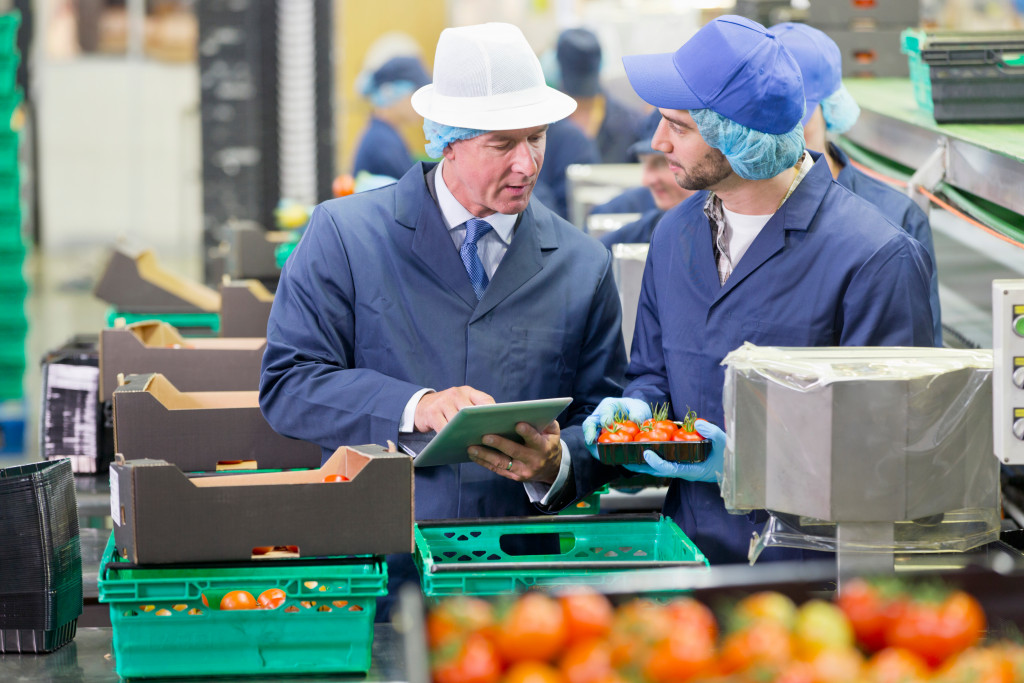• Employees should receive ongoing training on safety protocols, and new policies or procedures should be properly communicated.
• Wear appropriate personal protective equipment (PPE) while working in the facility and adhere to proper hygiene practices.
• Utilize Lock Out Tag Out (LOTO) procedures to reduce the risk of injuries and adhere to sanitation guidelines.
• Regularly inspect the facility for pests and garbage disposal, and have the pipes inspected by a professional service.
• Secure access control systems must be installed to regulate who can enter the facility and when.
As someone in the food processing industry, safety and security should always be top priorities. Food processing facilities daily handle hazardous materials, dangerous equipment, and sensitive customer data. You’ll need to take preventive measures to keep your facility secure and your employees safe. Explore what these steps are and how you can put them into practice.
Employee Training on Safety Protocols
When it comes to safety in the workplace, everyone needs to be on the same page. Employees should be trained on safety protocols such as handling hazardous materials, proper use of machinery, and secure storage of customer data. It is important to provide ongoing training and refreshers so that all employees are up-to-date with safety protocols. Additionally, new policies or procedures should be properly communicated, so everyone knows them.
Here are some of the other safety protocols that should be enforced in food processing facilities:
Wear Personal Protective Equipment (PPE)
PPEs are necessary to prevent workers from coming into contact with hazardous materials and germs. All employees should wear PPEs while working in the food processing facility to protect themselves and others. Make sure that the materials used for PPEs are made of quality materials such as steel-toe boots and protective gloves.

Maintain Proper Hygiene Practices
Food processing facilities should have strict hygiene practices to ensure food safety. Employees should always wash their hands before entering the facility, use sanitizing solutions to clean surfaces regularly and wear disposable gloves when handling raw ingredients. Additionally, all food contact surfaces should be cleaned and sanitized after every use.
Utilize Lock Out Tag Out (LOTO) Procedures
All operating machinery and equipment should have a lock-out tag-out procedure to reduce the risk of injuries. This means that when machinery is not in use, it needs to be locked or tagged to prevent accidental start-up. Additionally, any maintenance work on the machines should involve multiple people. Only authorized personnel should be allowed access to these areas.
Adhere to Sanitation Guidelines
Maintaining a clean and sanitary workplace is essential for food safety. All areas of the facility should be regularly inspected for the following:
Regular Pest Control
Pests such as rodents, cockroaches, and other insects may be present in the food processing facility and can carry germs and cause contamination. Since you are handling food, this may be a risk you need to take seriously. Regularly inspect and clean the facility for pests and, if needed, call in a professional pest control service.
Garbage Disposal

Proper disposal of waste is essential for health and safety. This is because the garbage can attract pests, spread germs, and contaminate food. Make sure that all waste is disposed of in designated areas to avoid any potential contamination. All garbage should be disposed of in designated containers and regularly emptied to prevent overflow. Additionally, these containers should be kept away from food processing areas or any other sensitive areas that may become contaminated by the waste.
Pipe Inspection
Pipes can be a breeding ground for germs and bacteria, which can cause contamination. A regular internal pipe inspection is important to ensure that the pipes are not leaking and there is no buildup of bacteria or other contaminants. A professional service should do this regularly to ensure that your facility meets safety requirements. Professionals can use pigging, ultrasonic, or internal pipeline cleaning to ensure the pipes are free of contaminants.
Secure Access Control Systems Need To Be Installed
Access control systems must be installed to regulate who can enter the facility and when they can enter it. For example, access control systems can help restrict certain areas of the facility to authorized personnel with specific clearance levels or prohibit access entirely after certain hours when the facility isn’t open for business operations anymore. This helps protect sensitive customer data from being accessed by unauthorized individuals and ensures that only those who have been properly trained can access hazardous materials or dangerous equipment at any given time.
Prevention is always better than cure, so ensure your food processing facility is secure and safe. These measures will help ensure a safer and more productive workplace. Regularly review and update these protocols to keep up with any new regulations or changes in technology as needed. This will help ensure that your facility is always up to industry standards.

